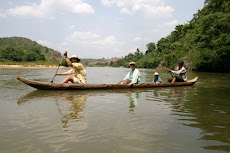She was a traveler too and a writer - a young newspaperwoman who left Melbourne in 1939 to report on Mussolini's invasion of Abyssinia - then on to London to cover the Queen Mother - and to meet and marry my father, a Yank flying RAF Spitfires against Hitler. She told stories and loved beer, so I know where I got it - but what did she get from her father?
For the past several years I have reached out for Granddad - finding his name in books, family memories and relics in my attic. I've had a box of Granddad's stuff since my first trip to Australia - his war diary, miscellaneous loose papers, a few photos, a canvas dispatch case, a pair of spurs - and a row of heavy silver and bronze medals. I took the canvas case with me to Vietnam and got it shot full of holes. Then it all sat in the attic until I was old enough to examine it for what is was - part of my DNA.
The Internet and computers make this possible. They connect me to vast webs of information and databases, like those at the Australian War Memorial Museum. The staff there took a personal interest and aided me greatly. They gave me documents and photos from their collection, and I gave them what they wanted from my attic. Together it tells quit a story - camels, cavalry, bridges, biplanes and bullets - and some of it is right here in Jerusalem.
We pilgrims continue our quest. I hold in my hand a photo from the Australian Museum's collection captioned:
"Captain Edward John Howells and an unidentified Australian soldier, both of D Field Troop Engineers, Royal Australian Bridging Train, in a narrow street in the Holy City of Jerusalem, local people passing the by. Capt Howells was awarded MC for leading the bridging team against the Turks on 21-22 March 1918." Granddad faces the camera, standing jaunty in his Army hat and boots. But standing where?

"Salaam 'alaykum" I greet a likely information source - a shopkeeper posted in front of his wares. "Could you tell me where this photo was taken?"
"Oh, please sir, hello, yes, come into my shop. I have many photos. I have olive wood grails, icons, holy relics. What would you like? Misses, look at this, it is very pretty. Come in, come in."
"Shukran. Thank you. But we are not shopping"
"Oh. Well just have a look around then. No cost for looking. Yes. Come in, come in!"
Repeated in many ways for days, this quest bares sweet fruit. We wander miles and miles through an ever-changing backdrop of thick walls and narrow winding ways. We get lost and found, drink sweet mint tea and eat things beyond pronunciation. We met and talk about Granddad with locals who might otherwise only see us as cash flow.
Up farther, toward the Muslim Quarter, standing in a doorway is an old gentleman who answers, "Good morning, how are you?" To his right is a row of black & white photographs on display. One is almost the same photo I hold in my hand - subtract the Australians. His father had taken the photo in 1935. We show him Granddad and he tells us exactly where to find the spot - even advises Jean when the lighting would be the same. He was right on both counts.

So we found Granddad - and stood where he stood. After 90 years he led us here to a timeless place in a time like no other. Can travel get better than this? I think not - but I am always willing to try.
Can it get worse? We must remember that things can always get worse. Tomorrow, we will try to cross into the West Bank, the Occupied Territory - for the Palestinian perspective - for better or worse.
- Seeking Stew
